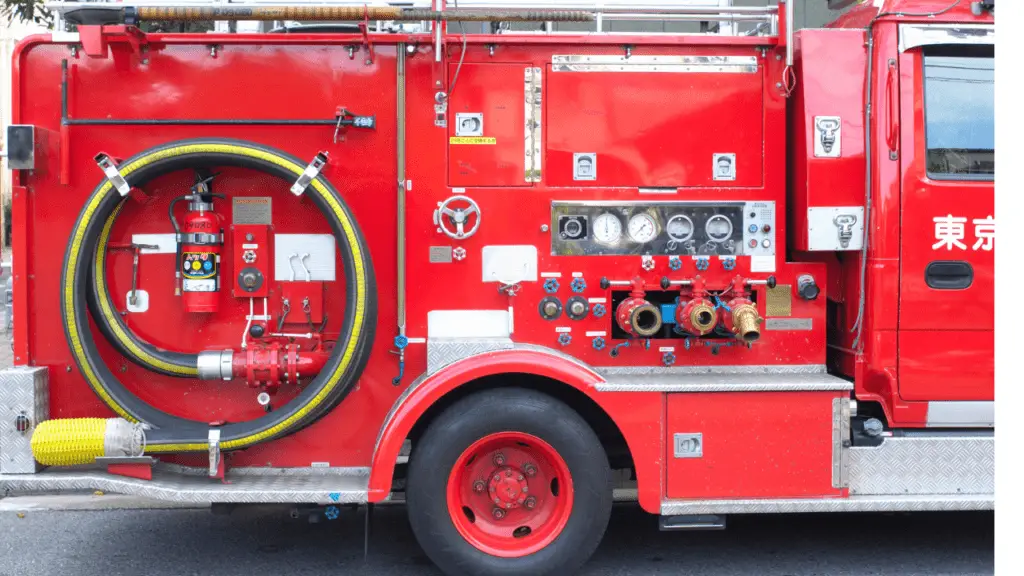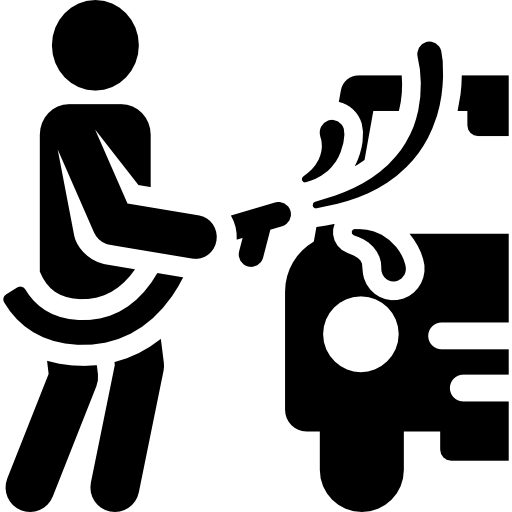Fire trucks are iconic symbols of emergency response, rushing to the scene with flashing lights and blaring sirens to combat blazing infernos. These vehicles play a vital role in firefighting, rescue operations, and disaster management.
A crucial factor that determines their effectiveness is the amount of water they can carry. In this article, we’ll dive deep into the question: “How much water does a fire truck hold?” Let’s explore the different capacities of fire trucks, their significance in firefighting efforts, and other essential aspects surrounding this topic.
Table of Contents
- 1 Understanding Fire Truck Water Capacity
- 2 The Varied Capacities of Fire Trucks
- 3 Importance of Water Capacity in Firefighting
- 4 Factors Affecting Water Carrying Capacity
- 5 Balancing Water Capacity and Maneuverability
- 6 The Role of Fire Trucks in Disaster Management
- 7 Fire Truck Water Systems: From Filling to Discharge
- 8 Challenges in Ensuring Adequate Water Supply
- 9 Innovations in Fire Truck Design and Technology
- 10 Conclusion
- 11 Frequently Asked Questions (FAQs)
Understanding Fire Truck Water Capacity
Fire trucks are designed to carry varying amounts of water, depending on their purpose and intended usage. They are classified into different categories based on their roles, such as pumper trucks, aerial trucks, and tanker-pumpers.

Classifications of Fire Trucks
Pumper Trucks: These are the most common fire trucks, equipped with pumps that can deliver water to the site of the fire. They are essential for urban firefighting and can carry a significant amount of water.
Aerial Trucks: Aerial fire trucks are equipped with ladders and platforms to access elevated positions. They also have water tanks, but their capacity might be lower due to the additional equipment they carry.
Tanker-Pumper vs. Aerial Fire Trucks
Tanker-Pumpers: These versatile trucks combine the functions of tankers and pumper trucks. They carry large amounts of water and can also pump water onto the fire, making them valuable for rural and remote firefighting.
Aerial Fire Trucks: While they have smaller water tanks, aerial trucks make up for it with their height and reach. They are crucial for rescues and reaching fires in multi-story buildings.
The Varied Capacities of Fire Trucks
The water-holding capacity of fire trucks can vary significantly based on their size, purpose, and the needs of the firefighting operation.
Small Municipal Fire Trucks
In smaller communities, where fire incidents might be less frequent, the fire trucks usually have a water capacity of around 500 to 1,000 gallons. These trucks are suitable for tackling smaller fires and provide initial support until larger units arrive.
Standard Fire Trucks
Standard pumper trucks, commonly seen in urban and suburban areas, typically hold between 1,000 and 2,000 gallons of water. This capacity allows them to address various fire scenarios effectively.
Large Capacity Industrial Fire Trucks
Industrial sites with potential fire hazards often require fire trucks with much larger water capacities. These specialized vehicles can carry 3,000 gallons or more, ensuring that they can handle extended firefighting operations.
Importance of Water Capacity in Firefighting
The water capacity of fire trucks is directly linked to their ability to combat fires efficiently.
Addressing Different Fire Scenarios
Fires come in various intensities and sizes. Having an adequate water supply on hand ensures that firefighters can address the flames effectively, preventing them from spreading and causing more damage.
Minimizing Reliance on External Water Sources
In areas with limited water infrastructure or during disasters that disrupt water supply, fire trucks with substantial water capacity become even more critical. They can operate independently and minimize reliance on external water sources.
Factors Affecting Water Carrying Capacity
Several factors influence how much water a fire truck can carry.
Truck Size and Weight
Larger trucks can accommodate larger water tanks, but they might be less maneuverable in tight spaces.
Equipment and Personnel Space
Fire trucks need to carry not only water but also essential equipment and personnel. Finding the right balance between water capacity and equipment storage is crucial.
Technological Innovations
Advancements in materials and design have allowed manufacturers to create fire trucks with optimized water storage solutions without compromising safety or performance.
Balancing Water Capacity and Maneuverability
Firefighters often face a dilemma between carrying more water and maintaining maneuverability.
Trade-offs in Water vs. Equipment
Larger tanks might mean sacrificing space for equipment or reducing the number of personnel on board. Fire departments must strike a balance based on their operational requirements.
Adapting to Urban and Rural Environments
In urban areas with fire hydrants, fire trucks might not need massive water tanks. However, rural and remote areas require trucks with higher water capacities due to limited water infrastructure.
The Role of Fire Trucks in Disaster Management
Fire trucks play a crucial role beyond firefighting, especially in disaster management.
Natural Disasters and Emergency Relief
During natural disasters like earthquakes or hurricanes, fire trucks are often involved in rescue and relief operations, providing water for affected communities and aiding in evacuation efforts.
Collaborative Efforts with Other Services
Fire departments collaborate with other emergency services, such as medical response teams and law enforcement, during large-scale emergencies. Adequate water capacity ensures seamless coordination and support.
Fire Truck Water Systems: From Filling to Discharge
Fire trucks have intricate water systems to ensure efficient water supply and distribution.
Water Sourcing and Filling Techniques
Firefighters can source water from hydrants, ponds, rivers, or other available sources. Quick and effective filling techniques are crucial to saving time during emergencies.
Pumping Mechanisms and Nozzles
Modern fire trucks are equipped with powerful pumps and specialized nozzles that allow firefighters to control the flow and direction of water, maximizing its effectiveness.
Challenges in Ensuring Adequate Water Supply

Despite advancements, challenges remain in ensuring a consistent water supply for firefighting operations.
Remote Locations and Limited Accessibility
Fires in remote or rugged terrain can be challenging to access, and water sources might be scarce. Specialized trucks with higher water capacities are essential in such scenarios.
Intensity and Duration of Fires
Some fires require a prolonged firefighting effort. Having enough water on hand is crucial to prevent depletion and ensure continuous firefighting operations.
Innovations in Fire Truck Design and Technology
The world of fire truck design is constantly evolving, incorporating new technologies and solutions.
Water Recycling and Eco-Friendly Solutions
Some fire trucks are now equipped with water recycling systems, allowing for more sustainable use of water resources during extended operations.
Integration of Communication and Data Systems
Modern fire trucks feature advanced communication and data systems that enable real-time coordination between different units and optimize response strategies.
Conclusion
In the realm of firefighting, the question “How much water does a fire truck hold?” is far from a mere technicality. The water capacity of these vehicles directly impacts their effectiveness in safeguarding lives and property.
From urban landscapes to remote terrains, fire trucks with varying water capacities play pivotal roles in disaster management and emergency response.
Striking the right balance between water supply, equipment storage, and maneuverability is essential to ensuring successful firefighting operations.
Frequently Asked Questions (FAQs)
Q: Can fire trucks access water from swimming pools?
A: Yes, fire trucks can source water from swimming pools during emergencies.
Q: Are there fire trucks that can carry foam for chemical fires?
A: Yes, specialized fire trucks equipped with foam tanks are used for extinguishing chemical fires.
Q: What is the typical lifespan of a fire truck?
A: Fire truck lifespans vary, but they generally serve for around 20 to 25 years before replacement.
Q: How fast can a fire truck fill its water tank?
A: Depending on the water source and equipment, fire trucks can fill their tanks in a matter of minutes.
Q: Are there fire trucks specifically designed for wildland firefighting?
A: Yes, wildland fire trucks are designed to navigate rough terrain and carry water for battling wildfires.
In conclusion, the water-holding capacity of fire trucks is a critical aspect of their functionality. These vehicles, ranging from compact municipal trucks to robust industrial ones, play an indispensable role in ensuring public safety during emergencies.
By understanding the nuances of fire truck water capacity, we gain insight into how these vehicles adapt to diverse scenarios, ultimately enhancing their effectiveness in safeguarding communities.







